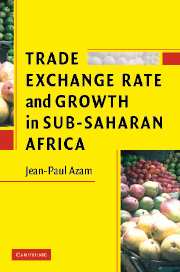Book contents
- Frontmatter
- Contents
- List of figures and tables
- Preface
- List of acronyms and abbreviations
- 1 Introduction and overview
- Part I Unrecorded trade in goods and currencies
- Part II Foreign exchange constraints
- Part III Longer-term growth in African countries
- 7 Exchange rate, growth, and poverty
- 8 Export crops, human capital, and endogenous growth
- 9 Ethnic rents and the politics of redistribution
- General conclusion
- References
- Index
8 - Export crops, human capital, and endogenous growth
Published online by Cambridge University Press: 26 May 2010
- Frontmatter
- Contents
- List of figures and tables
- Preface
- List of acronyms and abbreviations
- 1 Introduction and overview
- Part I Unrecorded trade in goods and currencies
- Part II Foreign exchange constraints
- Part III Longer-term growth in African countries
- 7 Exchange rate, growth, and poverty
- 8 Export crops, human capital, and endogenous growth
- 9 Ethnic rents and the politics of redistribution
- General conclusion
- References
- Index
Summary
Introduction
Côte d'Ivoire was up to the 1980s one of the few African success stories. At independence, it was a low-income country, raising no special hopes for fast growth. There were no mineral reserves, and agriculture was the only basis for economic development. Growth was driven by the rapid expansion of export revenues, mainly cocoa and coffee. By the end of the 1970s, Côte d'Ivoire was one of the wealthiest countries in Africa, exporting some manufactured goods. It then suffered like many other countries from a public investment explosion in the wake of the export boom of the late 1970s (Berthélemy and Bourguignon, 1996; Ghanem, 1999). Unsustainable macroeconomic imbalances and mounting indebtedness, aggravated by the high interest rates and the appreciation of the US dollar in terms of CFA Francs, making debt service obligations heavier, demanded an adjustment process, which began in 1980. By 1986, the adjustment process was complete, and the World Bank was optimistic (World Bank, 1987a). The success story, however, collapsed at the end of 1986 when the world prices of coffee and cocoa fell to historically low levels in real terms. The economy also took a long time to show any sign of recovery from what seemed, until the mid-1990s, a permanent adverse shift of its TOT.
- Type
- Chapter
- Information
- Trade, Exchange Rate, and Growth in Sub-Saharan Africa , pp. 197 - 212Publisher: Cambridge University PressPrint publication year: 2006



